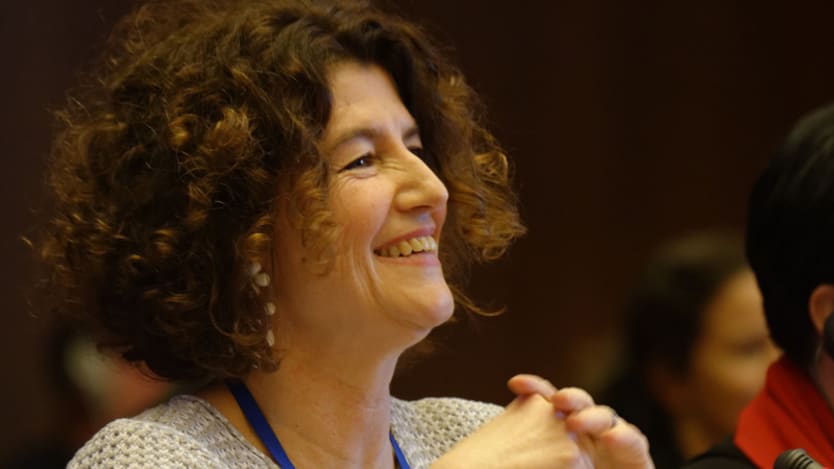
UNITED NATIONS — As the United Nations is considering additional measures to beef up its own sexual harassment policies, one agency — the International Labour Organization — is looking at trying to create a global set of standards around harassment and violence for workers.
ILO is considering a legally binding treaty that could protect all workers from violence and harassment in the workplace, if individual countries adopted and ratified the measure. The idea has been considered for the past decade, but conversations around a potential treaty have been ongoing for the past four years, preceding the #MeToo, and aid and development industry-specific #AidToo, movements.
At its annual meeting this spring, ILO held talks on its proposed treaty, which could be adopted and ratified by countries in 2019.
In a recent conversation, Manuela Tomei, director at ILO’s conditions of work and equality department, talked with Devex about why international standards for harassment and violence in the workplace are important, and what’s involved with implementing the potential treaty.
The conversation has been edited for length and clarity.
Can you discuss the idea behind developing these standards? Why was this considered necessary?
There is no international treaty that deals with the issue of violence and harassment in the world of work, so this is really filling a regulatory gap. The fact that there is no international treaty explains why you have such a diversity of terminology and why, in some cases, one word is used to refer to different situations, and vice versa.
The term “sexual harassment” may range from a sexist joke to rape. This is creating all sorts of confusion in terms of what is harassment, what is violence. There is a variety of ways whereby violence and harassment at work can be dealt with and it is important to ensure there is some sort of shared, common understanding of what we are talking about.
There is also the question of how to go about it. The concern is not only to intervene once violence has occurred, but it is also how to prevent it. This is the best way of ending violence, by prevention. And then, when it occurs, what is to be done and by who?
Countries could ratify this convention legally, but what would implementation at the local level look like?
You have a convention which is binding. That is very important for two reasons. It is not left to the goodwill of a company or a country to prevent and address violence and harassment. It is an obligation for those countries that ratify. The second thing is it sends out a strong political message, which is violence and harassment is unacceptable.
The convention gives rise to obligations for a country that ratifies it, one obligation is reporting back to ILO on what practical measures have been taken and then, what are the challenges, etcetera. Then we have a commision that reports and points to problems. The convention, because of its universal nature, has a degree of flexibility, but it needs to be implementable and to cover all workplaces. Depending on the size of the enterprise, depending on whether it is semiformal or informal, the strategies that can help will differ. It is not just the instrument, but it’s a battery of other tools you need to provide more practical, on the ground, hands-on guidance.
There might be some misconception about the scope of the convention — this would apply, potentially, to all workplaces, and would not be limited to just the U.N., correct?
It’s not meant only for the U.N. The U.N. now, which is working on its own policy of sexual harassment, is following very closely this standard setting. They would like to ensure that there is some consistency and also, to learn from a process that concerns the entire world.
What is your sense how the convention text will continue to evolve and what basic elements will be in there?
We have to finish the draft report and we’re waiting for comments from the constituents, which will be helpful. At the end of this process, there is no guarantee this would be adopted. This would be the first time that an international treaty is dealing with an issue that is very complex, universal in context, universal in nature, and which is also acquiring new facets with the changing world of work. Technological innovation is opening new opportunities — but also new opportunities in which violence and harassment can occur.
We are also trying to gather more evidence by sector, by size of enterprises. The evidence shows clearly that the incidence of violence or harassment is higher in certain sectors or occupations — usually those that have a lot of interface with the public, with students, with patients. It’s about coming up with better made, customized responses. This is a very important period in which we are engaging in consultation, but also in documenting good practices and trying to come up with something that could be of practical help.
And you feel there is some additional, public pressure placed on ILO to deliver on this issue?
Yes. This process started well before the #MeToo movement, which is good in the sense that it is not just a response to a phenomenon that has become more and more visible and less tolerated. We started 10 years ago and it took about six years for the governing body of ILO to decide that an international treaty was the right thing to do. Only four years ago they said, “let’s move onwards.”
The process is long. All in all, it’s four years with back and forth. When you ratify there is a supervision mechanism which kicks off and, therefore, has many implications.








